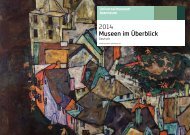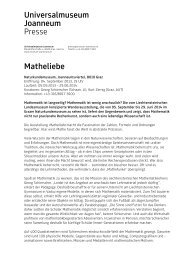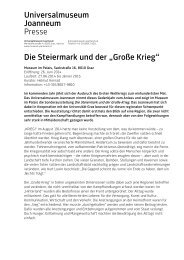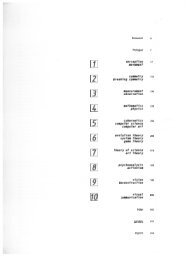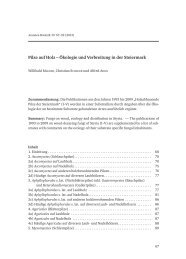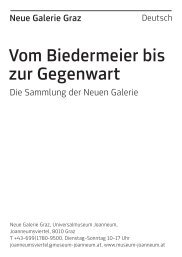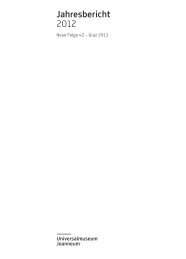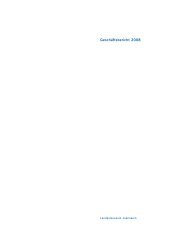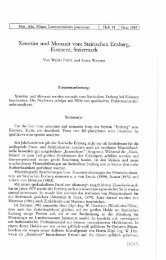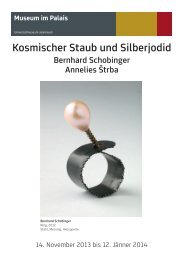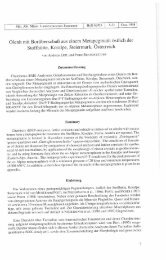Diana Thater gorillagorillagorilla - Universalmuseum Joanneum
Diana Thater gorillagorillagorilla - Universalmuseum Joanneum
Diana Thater gorillagorillagorilla - Universalmuseum Joanneum
Sie wollen auch ein ePaper? Erhöhen Sie die Reichweite Ihrer Titel.
YUMPU macht aus Druck-PDFs automatisch weboptimierte ePaper, die Google liebt.
edemption, so too the essential disruption that the ani ‑<br />
mal experiences in its being exposed in a nondisconceal‑<br />
ment drastically shortens the distance that the course had<br />
marked out between animal and man, between openness<br />
and non‑openness. That is to say that poverty in world –<br />
in which the animal in some way feels its own not‑being‑<br />
open – has the strategic function of ensuring a passage<br />
between the animal environment and the open, from a<br />
perspective in which captivation as the essence of the<br />
animal is “as it were a suitable background against which<br />
the essence of humanity can now be set off”.10<br />
At this point Heidegger can return to the discussion of bo ‑<br />
redom that had occupied him in the first part of the course,<br />
and can put animals captivation and the fundamental<br />
Stimmung that he had called “profound boredom” (tiefe<br />
Langeweile) in unexpected resonance with each other:<br />
“It will be seen how this fundamental attunement,11 and<br />
everything bound up with it, is to be set off over against<br />
what we claimed as the essence of animality, over against<br />
captivation. This contrast will become all the more decisive<br />
for us insofar as captivation, as precisely the essence of<br />
animality, apparently finds itself in the closest proximity to<br />
what we identified as a characteristic element of profound<br />
boredom and described as the enchantment‑enchain ‑<br />
ment (Gebanntheit) of Dasein within beings in their tota‑<br />
lity. Certainly it will be seen that this closest proximity<br />
of both essential constitutions is merely deceptive, and<br />
that an abyss lies between them which can not be brid ‑<br />
ged by any mediation whatsoever. Yet in that case the<br />
total divergence of these two theses will suddenly become<br />
very clear to us, and thereby the essence of world.”12<br />
Captivation appears here as a sort of fundamental Stim‑<br />
mung in which the animal does not open itself, as does<br />
Dasein, in a world, yet is nevertheless ecstatically drawn<br />
outside of itself in an exposure which disrupts it in its<br />
every fiber. And the understanding of the human world is<br />
possible only through the experience of the “closest proxi‑<br />
mity” – even if deceptive – to this exposure without dis‑<br />
concealment. Perhaps it is not the case that being and<br />
the human world have been presupposed in order then to<br />
reach the animal by means of subtraction – that is, by a<br />
“destructive observation”; perhaps the contrary is also, an<br />
even more, true, that is, that the openness of the human<br />
Giorgio Agamben 76 77<br />
world (insofar as it is also and primarily an openness to<br />
the essential conflict between disconcealment and conce‑<br />
alment) can be achieved only be means of an operation<br />
enacted upon the not‑open of the animal world. And the<br />
place of this operation – in which human openness in a<br />
world and animal openness toward its disinhibitor seem<br />
for a moment to meet – is boredom.<br />
Notes<br />
1 Martin Heidegger, Parmenides, trans. André Schuwer and Richard<br />
Rojcewicz. Bloomington: Indiana University Press 1992, p. 150; original in<br />
Martin Heidegger, Gesamtausgabe, vol. 44, Parmenides, ed. Manfred S.<br />
Frings. Frankfurt a. M.: Klostermann 1993, p. 224.<br />
2 Ibid., p. 115; original, p. 231.<br />
3 bid., p. 152; original, p. 226.<br />
4 bid., pp. 159–60; original, p. 237.<br />
5 Ibid., p. 160; original, p. 237–38.<br />
6 Ibid., original, p. 239.<br />
7 Ibid., pp. 160–61; original, p. 239.<br />
8 Martin Heidegger, The Fundamental Concepts of Metaphysics: World,<br />
Finititude, Solitiude, trans. William McNeill and Nicholas Walker. Blooming‑<br />
ton: Indiana University Press 1995, p. 225; original in Martin Heidegger,<br />
Gesamtausgabe, vol. 29–30, Die Grundbegriffe der Metaphysik. Welt –<br />
Endlichkeit – Einsamkeit. Frankfurt a. M.: Klostermann 1983, pp. 371–72.<br />
9 Ibid., pp. 272–73; original, pp. 395–96.<br />
10 Ibid., p. 282; original, p. 408.<br />
11 Agamben here translates Heidegger’s Stimmung as stato d’animo or<br />
“state of mind”. Stimmung – which is related to Stimme (“voice”) and stim‑<br />
men (“to tune [an instrument]”, “to be in tune”, “to accord”) – also carries<br />
the meaning for “(musical) pitch”, “(musical) key”, “disposition”, “feeling”.<br />
Macquarrie and Robinson translate it as “mood”. I have retained McNeill<br />
and Walker’s “attunement”. Agamben also occasionally refers to it as an<br />
“emotional tonality”.<br />
12 Ibid., p. 282; original, p. 409.



